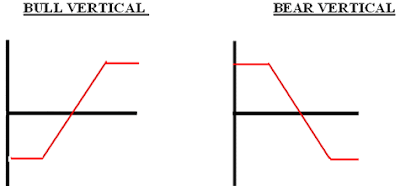by Stan Freifeld
For those of you who are wondering how the terms horizontal and vertical came into common usage, ponder no more. In a typical options chain or montage, the options are typically displayed in the format shown here. Calendar months listed horizontally and strike prices listed vertically.
As I typically like to do, let's start out with a definition.
A vertical spread is an options strategy in which options are bought and an equal number of options of the same type (puts or calls) are sold with different strike prices, but with the same expiration date.
Spread Trading: Bull and Bear Verticals
Vertical spreads are directional strategies, and are either bullish or bearish. This is what the generic expiration graphs look like:
The bull vertical can be constructed with either puts or calls. When it's done with calls, you buy a call and simultaneously sell a call at a higher strike. Since the call with the lower strike price will always be worth more than the call with the higher strike price, a bull vertical will always be established for a debit.
Similarly, a bear vertical can be constructed with puts by buying a put and selling a lower strike put. This construction will also always be done for a debit, since the higher strike put will always be more expensive than the lower strike put.
What's interesting about these spreads is that you can also construct the bull vertical with puts or the bear vertical with calls. These spreads will be done for credits, since you are selling the more expensive option and buying the less expensive one.
The following table should clear up any confusion:
Let's take an example using the above prices for options on XYZ stock, which is currently trading at $55. Suppose you're bullish on the stock over the next 35 days. You could buy a 55 call option for $3.18.
If XYZ increases by 10% to $60.50 at expiration, you will make $2.32 for each contract you bought. On the other hand, if you were wrong about the movement of XYZ, and it finishes constant at its current level, you'll lose the full amount of the purchase. In fact, just to break even, XYZ will have to increase to $58.18 at expiration.




















